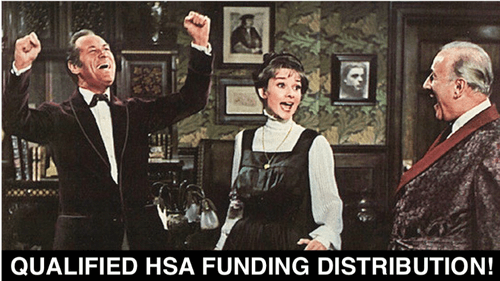Qualified HSA Funding Distribution (QHSAFD) is a sophisticated financial strategy that intertwines Health Savings Accounts (HSAs) and Individual Retirement Accounts (IRAs).
This technique allows individuals to make a one-time, tax-free transfer of funds from an IRA to an HSA, effectively merging retirement savings and healthcare financing.

What is a Qualified HSA Funding Distribution?
QHSAFDs provide an opportunity for individuals to leverage their IRA funds for healthcare expenses without incurring the typical tax penalties associated with early IRA distributions.
It’s essentially a rollover from an IRA or similar account to an HSA.
Except we usually don’t call it a “rollover”.” We call it a Qualified HSA Funding Distribution. And they are subject to different rules than most IRA or other retirement plan rollovers.
- The transfer is tax-free and can be up to the maximum HSA contribution limit for the year.
- The distribution must be made directly from the IRA to the HSA to qualify as tax-free.
- This strategy is only available once in a lifetime, with specific exceptions for changing HSA coverage mid-year.
Compare Pricing on the Best Insurance Plans Available
What You Need to Know About Qualified HSA Funding Distributions
Eligibility for a Qualified HSA Funding Distribution (QHSAFD) requires an HSA-eligible high-deductible health plan (HDHP) and an existing IRA.
First-time users can transfer up to the annual HSA contribution limit, which is $4,150 for individuals and $8,300 for families as of 2024.
If you’re 55 or older, you can transfer extra $1,000.
This rollover reduces your HSA contribution room for the year.
Points To Remember
- A QHSAFD counts towards your HSA limit but isn’t tax-deductible like regular contributions.
- Once made, a QHSAFD is final and cannot be reversed.
- It doesn’t affect Medicare or Social Security directly, but lowering IRA balances might influence Social Security taxes or Medicare premiums.
- The process must be a single transaction within a year; multiple transfers are not allowed. Exception: If your health insurance coverage changes from individual to family in the same tax year that you’ve already performed QHSAFD according to the individual coverage limit, you may perform a second distribution to reach the family limit.
- Exceeding HSA limits incurs penalties, requiring excess withdrawal.
- Both spouses with separate HSAs can make a QHSAFD, adhering to their HDHP coverage limits.
- Transfers are typically from Traditional or Roth IRAs, excluding active SEP or SIMPLE IRAs, and not from 401(k)s, 403(b)s, or inherited IRAs.
- The distribution must go to one HSA; splitting between HSAs is not permitted.
- The amount of the rollover reduces your HSA contribution limit for the year the distribution is made.
- You can’t make a QHSAFD from a 401(k) or 403(b).
- You can make a QHSAFD from inactive SEPs or SIMPLE IRAs, but only if they are enactive. That means that no contributions to those accounts have been made within the current tax year.
Compliance Considerations
The “last-month rule” allows full-year contributions if you’re eligible by December 1st.
But you must maintain eligibility throughout the next calendar year to avoid penalties on the QHSAFD.
Losing HSA eligibility the same tax year you execute the QHSAFD might lead to taxes and penalties.
Note that you can use multiple IRAs for a QHSAFD, but the total amount must not surpass the annual QHSAFD limit.
Inherited IRAs are not eligible for QHSAFDs.
Required Minimum Distributions and QHSAFDs
A QHSAFD can satisfy your IRA’s required minimum distribution (RMD) for the year if the transfer is made directly to the HSA.
While QHSAFD transfers are possible from a Roth IRA, it’s less beneficial due to Roth’s tax-free retirement distributions.
Transfers must be to the IRA holder’s HSA, not to a spouse’s.
Once the funds are in your HSA, you can use them to reimburse expenses incurred after the HSA’s establishment. Not before you executed your QHSAFD.
Note that all All transfers must be in cash, excluding “in-kind” distributions.
How to Initiate the QHSAFD Process
Start a QHSAFD by contacting your IRA custodian.
To minimize the chances of incurring penalties, ask your custodian for a direct trustee-to-trustee QHSAFD transfer to your health savings account.
The QHSAFD Testing Period
QHSAFD transactions come with a mandated testing phase.
For the distribution to be exempt from taxes, you need to sustain your qualification for a high-deductible health plan (HDHP) and the ability to contribute to an HSA through the last month of the year succeeding the one in which the QHSAFD is executed.
If you anticipate losing your HSA contribution eligibility or foresee relinquishing it within the upcoming 13 months, opting for a QHSAFD might not be the most prudent choice.
QHSAFDs and Medicare Enrollment
If you enroll in Medicare within 12 months of executing a QHSAFD, you will fail the test. Your QHSAFD will not qualify for favorable tax treatment. It will be considered a normal distribution.
Advantages of QHSAFDs
QHSAFD offers several benefits for those looking to optimize their financial planning for healthcare costs.
- Immediate tax savings, thanks to the reduction in taxable income
- Enhanced flexibility in using retirement funds for current healthcare expenses without penalty
- Preservation of HSA funds for future medical costs or investment growth
Disadvantages of QHSAFDs
While a QHSAFD provides a valuable once-in-a-lifetime opportunity for tax planning, it also has some drawbacks:
- You can only do it one time. Exception: you may do another QHSAFD if your HDHP that qualifies you to make HSA contributions changes from a self-only plan to a family plan.
- Reducing IRA balances may impact long-term retirement planning and income.
- While HSA assets receive very favorable tax treatment while you are alive, inherited HSA balances do not receive the same tax treatment. Inherited IRAs may be more favorably treated, especially for non-spouse beneficiaries.
Strategic Considerations for QHSAFDs
Implementing a QHSAFD requires strategic planning to maximize benefits and minimize drawbacks.
- QHSAFDs are best suited for those who have incurred or anticipate significant healthcare expenses.
- Balancing the immediate tax benefits with potential future healthcare needs is key.
- The longer you wait, the more you will likely be able to contribute. This is because HSA contribution limits go up each year with the cost of living. Also, you get a higher contribution limit if you wait until you reach age 55 or older.
Compare Pricing on the Best HealthShare Plans Available
Conclusion: Is QHSAFD Right for You?
Qualified HSA Funding Distribution from an IRA is a useful tool in the right circumstances. HSAs offer terrific tax advantages, and they aren’t subject to RMDs.
This makes them a very tax-efficient asset to hold into retirement – even if you wind up not needing the money for health care.
However, its implications for retirement planning and tax compliance necessitate careful consideration and expert guidance.
If you need an HSA-qualified health plan, give us a call and talk to one of our expert Personal Benefits Managers. And when you’re ready to fund the HSA, they can help you decide if you want to use money from your HSA to do so.
For Further Reading: How Much Can An HSA Save in Taxes? | Can I Transfer Money From an IRA to an HSA? | Up Your HSA Game With These Three Investment Strategies


